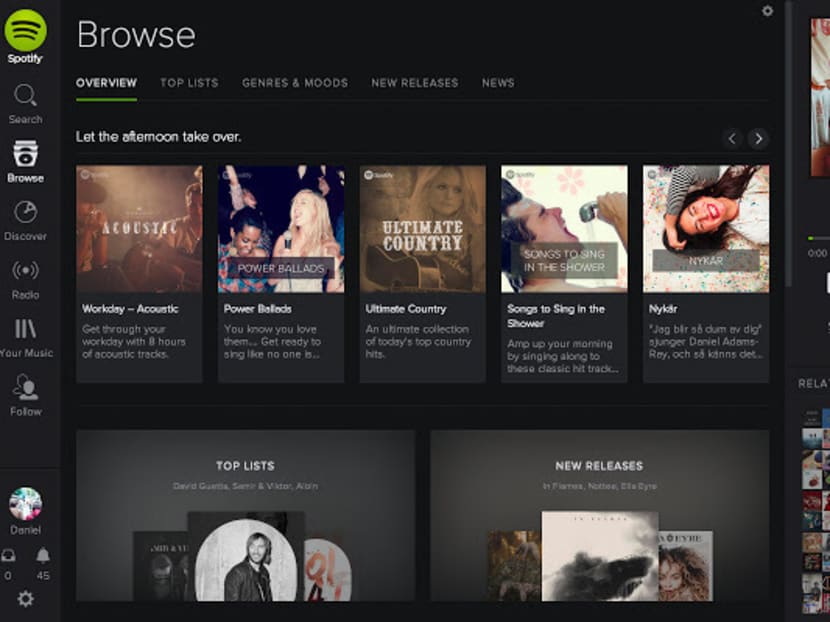Spotify can’t live on that monthly subscription fee alone: Gadfly
PARIS — With Spotify shooting for a public listing next year, it’s time for the leading independent music-streaming service to step up its game.

Spotify needs to rethink its subscription formula if they want to stay in for the long haul. Photo: Spotify
PARIS — With Spotify shooting for a public listing next year, it’s time for the leading independent music-streaming service to step up its game.
No more blaming the big, bad record labels for everything. No more excuses for why the business remains stubbornly unprofitable despite doubling revenue last year and adding subscribers rapidly.
Spotify does suffer from paying 70 per cent or more of its revenue to the music industry, but those fees are not necessarily a death sentence. So here is some advice: Spotify should take a baseball bat to its pricing structure, namely the US$9.99 (S$13.63) monthly cost for its all-you-can-eat subscription service. (Spotify’s price is generally consistent across much of the globe, although it is lower in some emerging markets where consumers’ purchasing power is lower. In Singapore, for example, it is S$9.90.)
That price — now a standard for comparable streaming offers from Apple, Tidal, Deezer and others — is an artefact of the record-store business model. It became obsolete long ago.
Spotify should start segmenting the market to appeal to more people, a tactic prevalent in other subscription businesses like video games and cable TV packages.
Why not a $3.99 offer limited to country music? Or a $7.99 monthly subscription for dance music fans fortified with exclusive playlists or live streams from Ibiza clubs? Then get creative with a premium option for $19.99 a month featuring high-quality sound and other goodies.
The Big Three record labels control most of the supply of popular music, and they may have to bend their terms for Spotify to experiment with its monthly cost. They do capitulate when it suits them.
The labels are negotiating for a $4 or $5 monthly limited music streaming option that would work only through Amazon’s Echo home speaker. And Spotify is powerful enough to throw its weight around with the music powers, as it’s doing to punish musicians with Apple Music or Tidal exclusives. Spotify accounts for more than 10 per cent of the record labels’ revenue, Bloomberg News has reported.
Deviating from the flat monthly subscription is more complex for prospective users and for Spotify itself. Any mid-tier, cheaper offer must be structured carefully so as not to cannibalise the base nor result in money being lost on each customer. Spotify’s deals with record labels, which are being renegotiated, include minimum guaranteed payments plus a fee for each song streamed, so it can’t cut prices too deeply.
Nevertheless, more price points would be good for Spotify’s central mission: Persuading more people to sign up for paid subscriptions. Spotify has three times more users for its free music-streaming option, which includes ads, than its 39 million paid customers as of June.
We’re not necessarily calling for a future where no music is available without tolls. But Spotify’s free option is too good, and Spotify makes 90 per cent of its revenue from the paying subscribers. It needs more of them to become sustainable.
Only about 10 per cent of music buyers spend $10 or more a month on music, across all recorded formats, and most of those have already been converted to subscriptions, according to music analyst Mr Mark Mulligan. Spotify needs to give the masses a way to get on board for less and then try to migrate some to the full-priced product.
Free or low-cost introductory Spotify subscriptions as part of mobile phone plans are already de facto lower-price tiers, and they work. The telecom bundles represented more than one-fifth of global music subscribers in 2015, Mr Mulligan estimates. Spotify also has lower prices for students and a family plan that includes up to six users for US$14.99 a month.
Dividing Spotify’s all-you-can-eat subscription into different niches won’t be a panacea. Spotify is also doing other smart things to reduce its dependency on the music labels, such as adding video content.
Given the tough economics imposed by the music industry, it may be impossible for music services to survive unless they’re owned by Google, Apple or Amazon. That would be a sad state of affairs for the music industry, for consumers and for innovative independent digital music companies like Spotify. But Spotify has to help itself by tinkering with the industry-standard $10 music fee. It’s not hyperbole to say getting the subscription model right is a life-or-death decision for Spotify. BLOOMBERG





